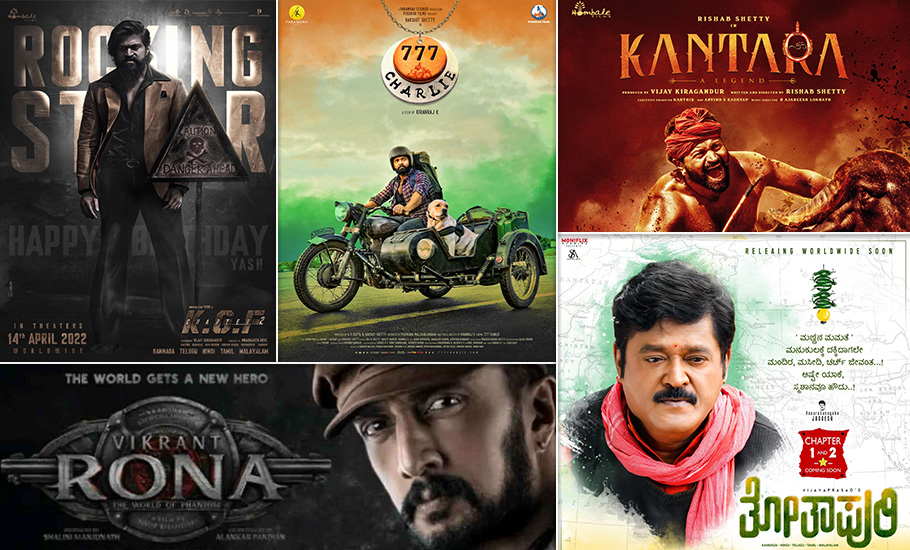
Kannada films increase focus on original content, but not everybody is happy
The shift to original content is bleeding Sandalwood dry, as remakes take much less time and money, complain stakeholders

Kannada filmmakers seem to have lost their liking for remake films. Sandalwood is now focusing on original content, which was a rarity until a few years ago. This trend might inspire budding filmmakers and audiences looking for fresh content, but it has left the Kannada film industry bleeding.
Films like KGF, Charlie 777, and Vikrant Rona have brought immense pride to the Kannada film industry, but these comprise a fraction of the films made in Sandalwood. The Kannada film industry releases 200 to 250 films a year, and less than 10% of these films create a buzz. Not even half a dozen films are commercial hits every year.
The Kannada film industry has fewer than a dozen superstars, and almost everyone makes only one film every two years. Producers say that actors and directors are bent on creating original content. As a result, films are taking inordinately long to complete, burning a hole in producers’ pockets.
Also read: Kannada-dubbed version of Ponniyin Selvan finds few takers
The OTT effect
Technology has certainly brought in positive changes to film industries across the country, but it has also affected trade. OTT platforms, subtitles, dubbed films, and cheap mobile data have increased the overall viewership of a film, but has also caused a dent in filmmakers’ businesses.
Easy access to a variety of content has made audiences more aware and careful about where to spend their money. Audiences can now connect with stories across the language bar, thanks to subtitles and dubbed content. They can identify if a film or a scene has been “inspired” by one across borders, putting directors and actors in a tight spot. Hence the need for original content.
“Technology has affected the film trade. Until a few years ago, we would release films in a limited number of theatres in certain regions and keep rotating them. It was the era of ‘print’ those days. We had to spend about Rs 1.5 lakh for a single print, and most producers would get about 50 to 60 prints and rotate them. We would shift films from theatres in A centres to B and then C centres over a period,” revealed director and producer S Krishna.
“Today, it is possible to release films in every nook and corner of the country simultaneously using digital technology. While it might sound like a positive development, the audiences are also fed with content from across borders, as they are up to date with the latest content. If we serve them the same or similar content, they will outright reject it,” he admitted.
Also read: Trade report: Bollywood loses its fizz as South films uncork the bubbly
Onus on superstars
Producers have often spoken about the need for superstars to make at least two to three films a year for the industry to survive. Indeed, they used to do that when remakes were the norm. If a superstar’s film did not do well at the box office, another film of his would hit the theatres within a few months.
But the challenge in delivering original content has made things difficult. Today, the industry must wait for another at least two years for a superstar to come up with another film irrespective of his previous film’s fate at the box office.
Remakes have turned several actors into superstars overnight. They revived the careers of many and raked in the moolah for producers. “‘Yajamana’ and ‘Surya Vamsha’ made more business in Kannada than the original language (Tamil). We need good scriptwriters and directors to transform stories to suit our ethos and remake them,” said producer and distributor, K Manju.
“Remake films are always a safe bet. These days, directors spend 100 to 120 days shooting, and the final output is two hours and 15 minutes. One can imagine how much time, money, and energy are wasted by shooting for so many days. If it is a remake film, it is easy to calculate the number of shooting days and the final output. We lack technicians who can plan a film and stick to a budget,” he revealed.
Also read: Pro-Kannada outfit against screening Marathi film
Consistency is key
In the past, several directors in the Kannada film industry have come up with original scripts that have swept the audiences off their feet. But a few films down the line, they have chosen the remake path. Superstar Upendra is one such example. The maverick director came up with original scripts in different genres but chose to remake films after playing the lead in a couple of films.
“Business has taken over everything. Filmmakers want success and fame at any cost and are willing to give up their core beliefs. Remakes spoilt the Kannada film industry. We have seen such trends earlier (where directors worked with original stories), but a few films later, they chose to play it safe with remakes. The trend has started again, but they need to be consistent in what they are doing,” said senior journalist B Ganapathi.
The era between the 1960s and ’80s was the golden period for the Kannada film industry. Original content ruled the roost. Filmmakers from across the country took the remake rights of Kannada films and turned them into blockbusters in their respective languages. However, over the past few decades, superstars, including Shivaraj Kumar, Sudeep, Darshan, and the late Puneeth Rajkumar, have appeared in remakes.
While it seems to be a thing of the past, not everyone looks happy with the new trend.


